Unmanned Electric Tugboat Formation Multi-Agent Energy-Aware Control System Concept
Abstract
1. Introduction
2. Multi-Agent Systems and Autonomous Vessels
2.1. Multi-Agent Systems
2.2. Autonomous Sea Vessels
2.3. Energy Awareness
3. Tugboat Formation Multi-Agent Control System
3.1. Tugboat Formation Concept
3.2. Tugboats
3.3. Energy-Aware Formation Example Scenario
4. Tugboat Formation Multi-Agent Control System
4.1. Single Tug Resistance
4.2. Tug Formation Resistance
4.3. Tug Formation Resistance Simulation Tests
5. Conclusions
Author Contributions
Funding
Conflicts of Interest
References
- Robert Allan Ltd. Revolutionary RAMORA Brings Tele-Operated Capability to Ship Handling. Available online: https://ral.ca/2015/09/18/revolutionary-ramora-brings-tele-operated-capability-to-ship-handling/ (accessed on 26 November 2020).
- Ed Garsten. Autonomous Tug Finds Its Way Home. Available online: https://www.forbes.com/sites/edgarsten/2021/10/20/autonomous-tug-odyssey-completed/?sh=108e5c506c49 (accessed on 10 October 2022).
- Miller, A.; Rybczak, M.; Rak, A. Towards the Autonomy: Control Systems for the Ship in Confined and Open Waters. Sensors 2021, 21, 2286. [Google Scholar] [CrossRef] [PubMed]
- Mohamed-Seghir, M.; Kula, K.; Kouzou, A. Artificial Intelligence-Based Methods for Decision Support to Avoid Collisions at Sea. Electronics 2021, 10, 2360. [Google Scholar] [CrossRef]
- Navtek Naval Technologies. World’s First All-Electric Tugboat Delivered, Three More on the Way. Available online: https://www.maritime-executive.com/features/world-s-first-all-electric-tugboat-delivered-three-more-on-the-way-1 (accessed on 8 December 2020).
- Damen. Damen’s First All-Electric Tug Sparky Delivered to Ports of Auckland. Available online: https://www.damen.com/insights-center/news/damen-s-first-all-electric-tug-sparky-delivered-to-ports-of-auckland (accessed on 10 October 2022).
- IMO. Energy Efficiency Measures. Available online: https://www.imo.org/en/OurWork/Environment/Pages/Technical-and-Operational-Measures.aspx (accessed on 16 November 2022).
- Stanković, R.; Štula, M.; Maras, J. Evaluating fault tolerance approaches in multi-agent systems. Auton Agent Multi-Agent Syst. 2017, 31, 151–177. [Google Scholar] [CrossRef]
- Schiaretti, M.; Chen, L.; Negenborn, R.R. Survey on Autonomous Surface Vessels: Part I—A New Detailed Definition of Autonomy Levels. In Proceedings of the 8th International Conference, ICCL, Southampton, UK, 18–20 October 2017; Volume 10572, pp. 219–233. [Google Scholar] [CrossRef]
- Schiaretti, M.; Chen, L.; Negenborn, R.R. Survey on Autonomous Surface Vessels: Part II—Categorization of 60 Prototypes and Future Applications. In Proceedings of the Computational Logistics, 8th International Conference, ICCL 2017, Southampton, UK, 18–20 October 2017; pp. 245–263. [Google Scholar] [CrossRef]
- Devaraju, A.; Chen, L.; Negenborn, R.R. Autonomous Surface Vessels in Ports: Applications, Technologies and Port Infrastructures. Comput. Logist. 2018, 11184, 86–105. [Google Scholar] [CrossRef]
- The Engineer. Rolls-Royce and Svitzer Demonstrate World’s First Remotely Operated Commercial Vessel. Available online: https://www.theengineer.co.uk/rolls-royce-and-svitzer-demonstrate-worlds-first-remotely-operated-commercial-vessel/ (accessed on 16 November 2022).
- van Tran, L.; Im, N. A study on ship automatic berthing with assistance of auxiliary devices. Int. J. Nav. Archit. Ocean. Eng. 2012, 4, 199–210. [Google Scholar] [CrossRef]
- van Bui, P.; Kawai, H.; Kim, Y.B.; Lee, K.S. A ship berthing system design with four tug boats. J. Mech. Sci. Technol. 2011, 25, 1257–1264. [Google Scholar] [CrossRef]
- Esposito, J.; Feemster, M.; Smith, E. Cooperative manipulation on the water using a swarm of autonomous tugboats. In Proceedings of the 2008 IEEE International Conference on Robotics and Automation, Pasadena, CA, USA, 19–23 May 2008; pp. 1501–1506. [Google Scholar] [CrossRef]
- Sartoretti, G.; Shaw, S.; Hsieh, M.A. Distributed planar manipulation in fluidic environments. In Proceedings of the 2016 IEEE International Conference on Robotics and Automation (ICRA), Stockholm, Sweden, 16–21 May 2016; pp. 5322–5327. [Google Scholar] [CrossRef]
- van Bui, P.; Ji, S.W.; Jang, J.S.; Kim, Y.B. Ship Trajectory Tracking in Harbour Area by Using Autonomous Tugboats. IFAC Proc. Vol. 2012, 45, 740–745. [Google Scholar] [CrossRef]
- Abramowicz-Gerigk, T.; Burciu, Z. Application of Ship Motion Simulation in Reliability Assessment of Ship Entrance into the Port. TransNav 2016, 10, 613–617. [Google Scholar] [CrossRef]
- Przybyłowski, A.; Kałaska, A.; Przybyłowski, P. Quest for a Tool Measuring Urban Quality of Life: ISO 37120 Standard Sustainable Development Indicators. Energies 2022, 15, 2841. [Google Scholar] [CrossRef]
- Braganza, D.; Feemster, M.; Dawson, D. Positioning of Large Surface Vessels using Multiple Tugboats. In Proceedings of the 2007 American Control Conference, New York, NY, USA, 9–13 July 2007; pp. 912–917. [Google Scholar] [CrossRef]
- Vojković, G.; Milenković, M. Autonomous ships and legal authorities of the ship master. Case Stud. Transp. Policy 2020, 8, 333–340. [Google Scholar] [CrossRef]
- Jin, Q.; Wu, G.; Boriboonsomsin, K.; Barth, M. Platoon-based multi-agent intersection management for connected vehicle. In Proceedings of the 16th International IEEE Conference on Intelligent Transportation Systems (ITSC 2013), The Hague, The Netherlands, 6–9 October 2013; pp. 1462–1467. [Google Scholar] [CrossRef]
- Czech, P.; Turoń, K.; Barcik, J. Autonomous vehicles: Basic issues. SJSUT.ST 2018, 100, 15–22. [Google Scholar] [CrossRef]
- He, Y.; Mou, J.; Chen, L.; Zeng, Q.; Huang, Y.; Chen, P.; Zhang, S. Will sailing in formation reduce energy consumption? Numerical prediction of resistance for ships in different formation configurations. Appl. Energy 2022, 312, 118695. [Google Scholar] [CrossRef]
- Dong, Z.; Liang, X.; Guan, X.; Li, W. Formation optimization of various spacing configurations for a fleet of unmanned surface vehicles based on a hydrodynamic energy-saving strategy. Ocean. Eng. 2022, 266, 112824. [Google Scholar] [CrossRef]
- Abramowicz-Gerigk, T.; Burciu, Z.; Hapke, L. Innovative Project of Propellers and Thrusters Jet Loads during Ship Berthing Monitoring System. TransNav 2019, 13, 861–865. [Google Scholar] [CrossRef]
- Iwaszkiewicz, J.; Muc, A.; Bielecka, A. Polar Voltage Space Vectors of the Six-Phase Two-Level VSI. Energies 2022, 15, 2763. [Google Scholar] [CrossRef]
- Iwaszkiewicz, J. Sterowanie dwupoziomowego pięciofazowego falownika napięcia przy obciążeniu połączonym w gwiazdę. Electrotech. Rev. 2022, 1, 127–130. [Google Scholar] [CrossRef]
- Nuchturee, C.; Li, T.; Xia, H. Energy efficiency of integrated electric propulsion for ships – A review. Renew. Sustain. Energy Rev. 2020, 134, 110145. [Google Scholar] [CrossRef]
- Shiraishi, K.; Minami, S.; Kobayashi, K.; Kodera, M. Development of A Hybrid Tugboat Propulsion System. MTZ Ind 2013, 3, 36–43. [Google Scholar] [CrossRef]
- Zali, M.A.; Ahmad, W.K.W.; Retnam, A.; Catrina, N. Concentration of Heavy Metals in Virgin, Used, Recovered and Waste Oil: A Spectroscopic Study. Procedia Environ. Sci. 2015, 30, 201–204. [Google Scholar] [CrossRef]
- Baszanowska, E.; Otremba, Z. Spectral signatures of fluorescence and light absorption to identify crude oils found in the marine environment. JEOS:RP 2014, 9. [Google Scholar] [CrossRef]
- European Parliament. Directive 2005/33/EC Regarding the Sulphur Content of Marine Fuels. Available online: https://eur-lex.europa.eu/LexUriServ/LexUriServ.do?uri=OJ:L:2005:191:0059:0069:EN:PDF (accessed on 16 November 2022).
- European Comission. COMMISSION RECOMMENDATION on the Promotion of Shore-Side Electricity for Use by Ships at Berth in Community Ports. Available online: https://eur-lex.europa.eu/LexUriServ/LexUriServ.do?uri=OJ:L:2006:125:0038:0042:EN:PDF (accessed on 16 November 2022).
- Zubi, G.; Dufo-López, R.; Carvalho, M.; Pasaoglu, G. The lithium-ion battery: State of the art and future perspectives. Renew. Sustain. Energy Rev. 2018, 89, 292–308. [Google Scholar] [CrossRef]
- Cavalcanti, E.J.C. Energy, exergy and exergoenvironmental analyses on gas-diesel fuel marine engine used for trigeneration system. Appl. Therm. Eng. 2021, 184, 116211. [Google Scholar] [CrossRef]
- Deng, Q.; Lin, B. Automated machine learning structure-composition-property relationships of perovskite materials for energy conversion and storage. Energy Mater 2021, 1, 100006. [Google Scholar] [CrossRef]
- Stemmann-Technik. FerryCHARGER for Electric Ferries. Available online: http://www.stemmann.com/en/products/charging_systems/ferrycharger (accessed on 8 January 2021).
- Siemens. Siemens’ Record-Fast Charging Batteries Convert Norway’s Ferry Route to Electric Power. Available online: https://press.siemens.com/global/en/news/siemens-record-fast-charging-batteries-convert-norways-ferry-route-electric-power (accessed on 8 January 2021).
- Tuck, E.; Lazauskas, L. DRAG ON A SHIP AND MICHELL’S INTEGRAL. In Proceedings of the XXII International Congress of Theoretical and Applied Mechanics; XXII ICTAM, Adelaide, Australia, 25–29 August 2008. [Google Scholar]
- Scarlat, N.; Prussi, M.; Padella, M. Quantification of the carbon intensity of electricity produced and used in Europe. Appl. Energy 2022, 305, 117901. [Google Scholar] [CrossRef]

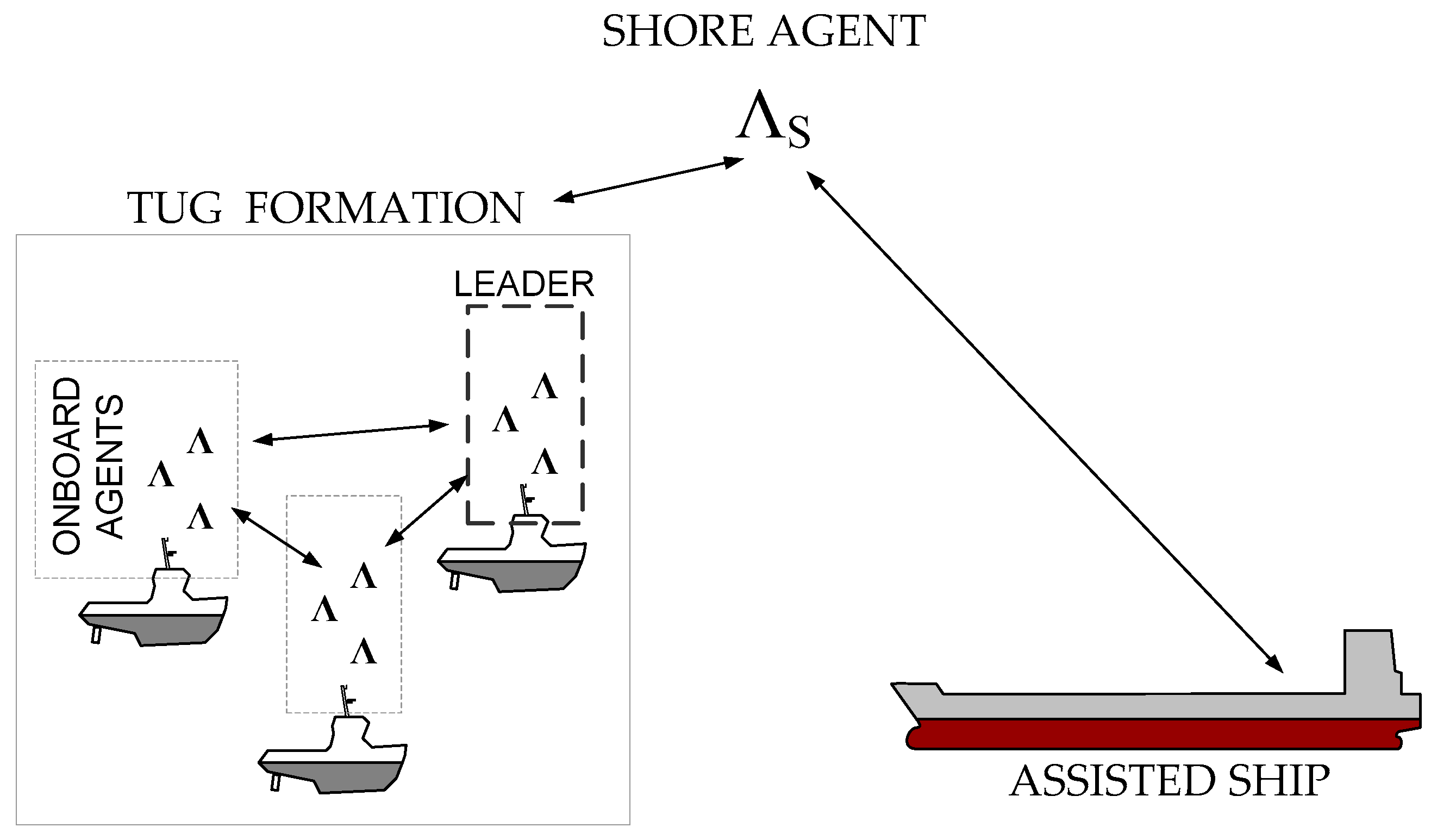

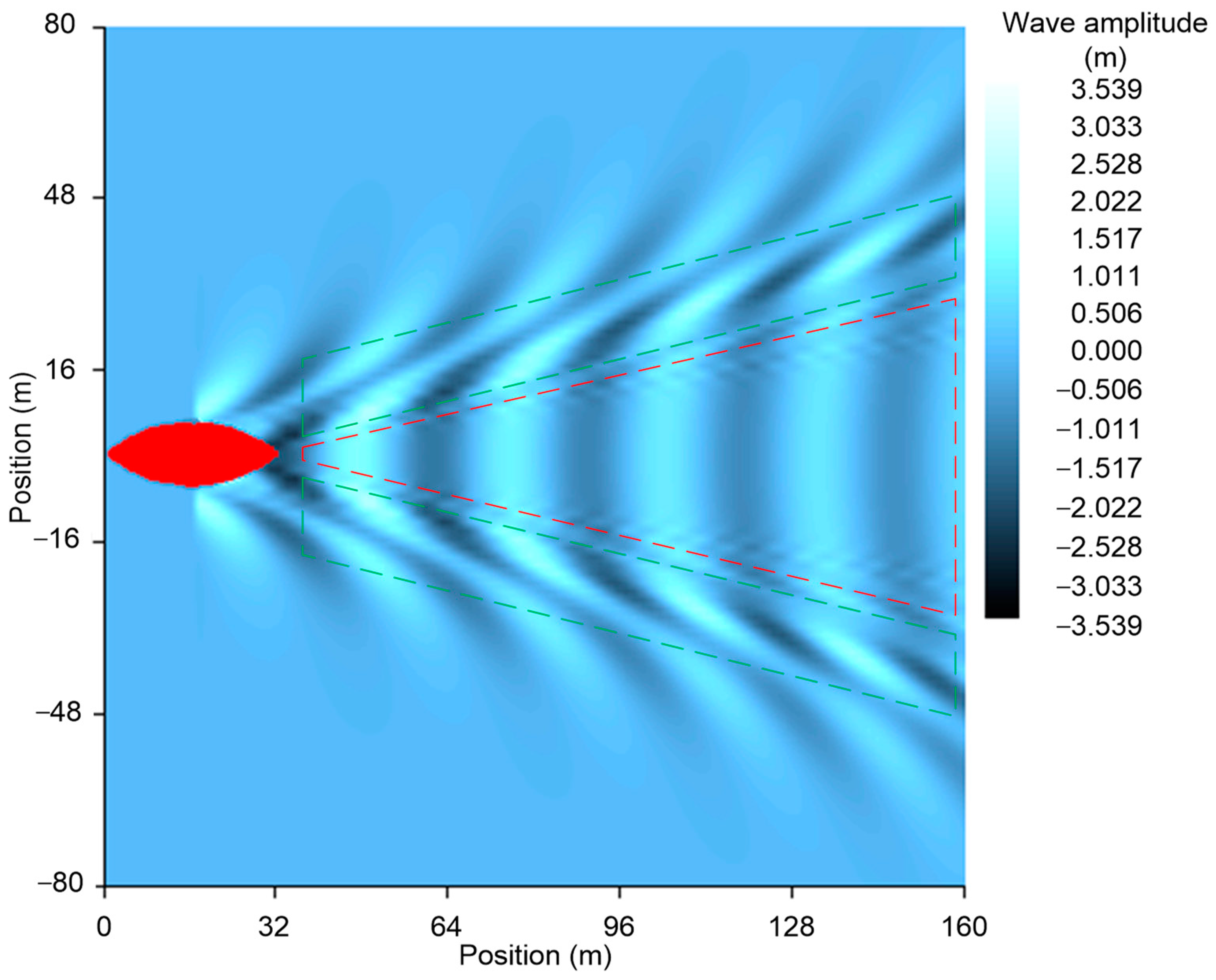
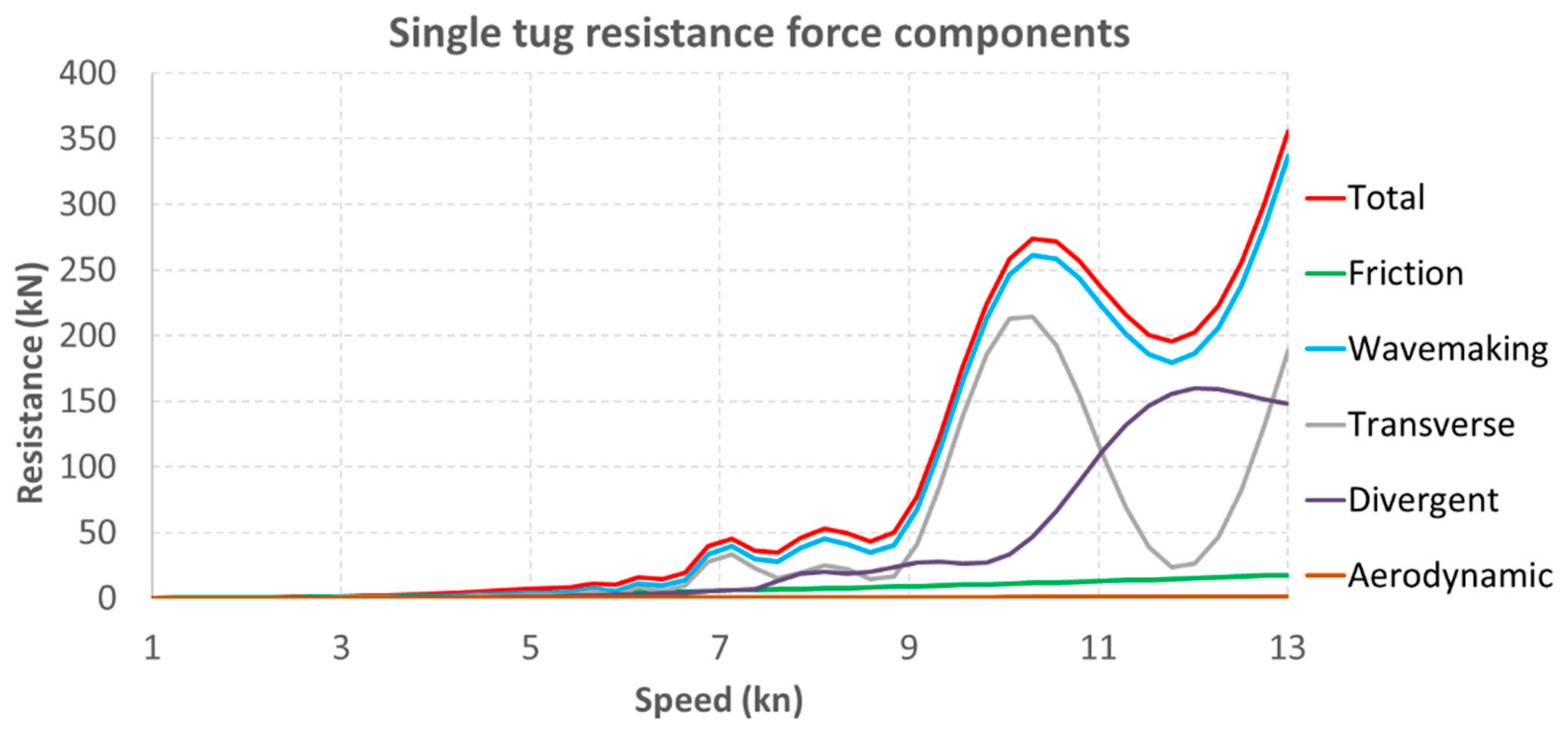
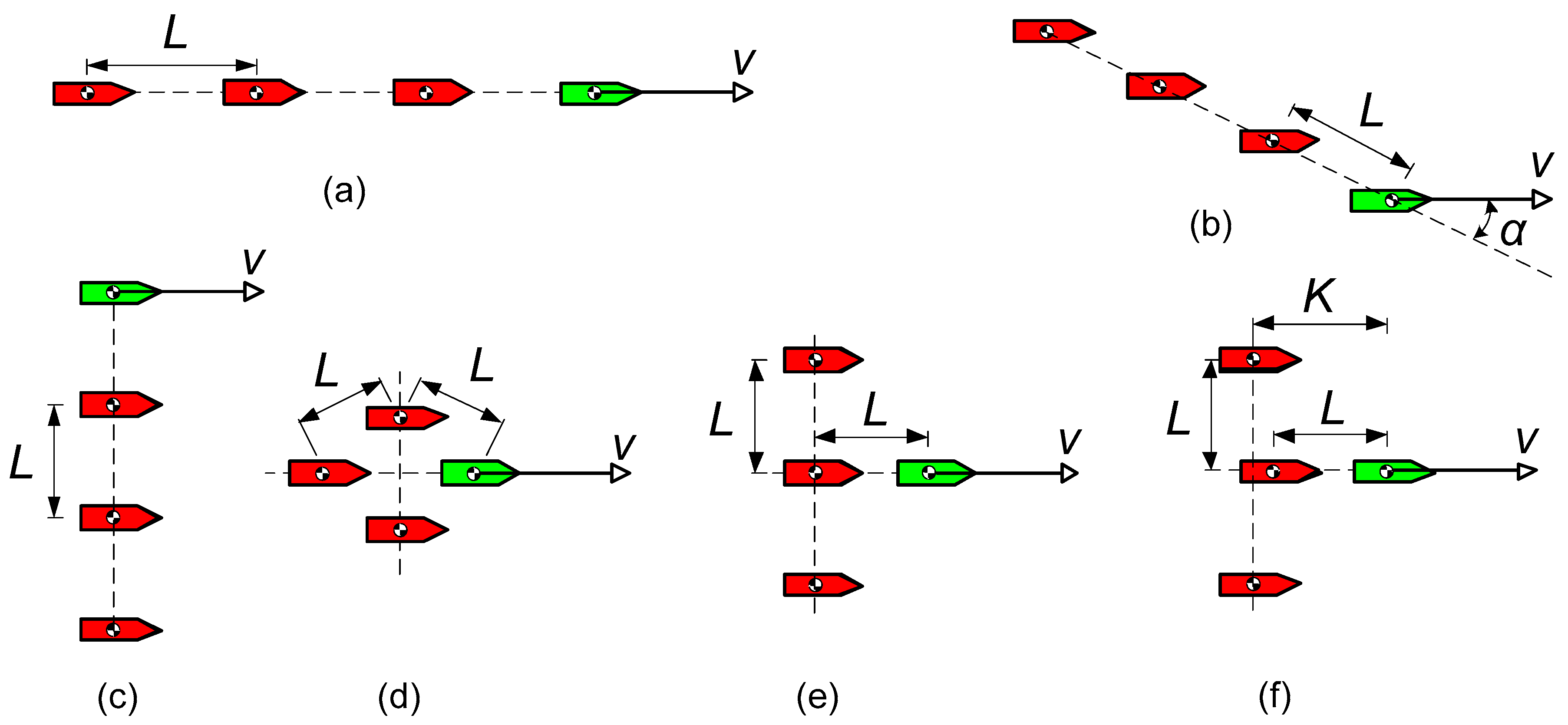
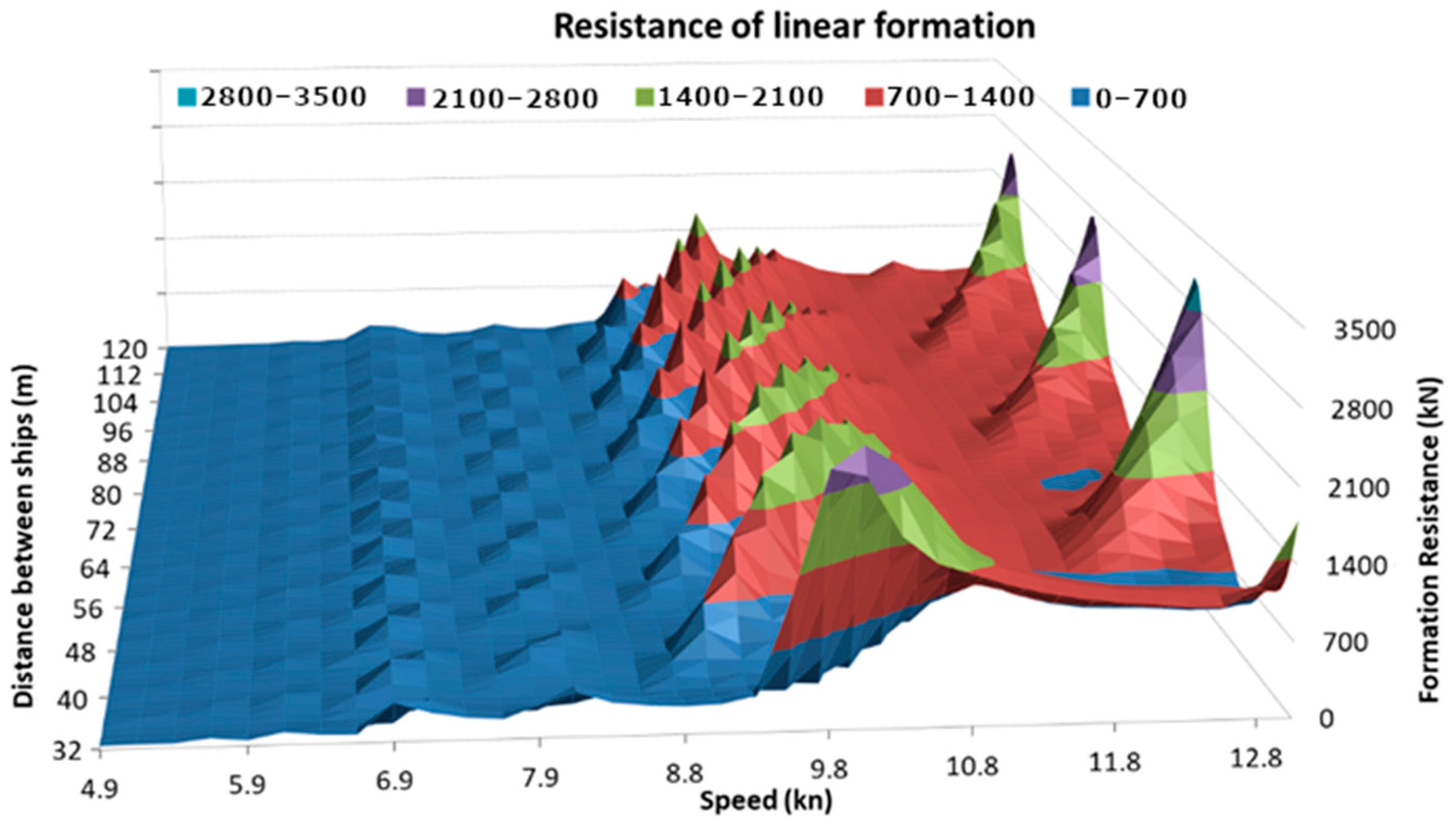
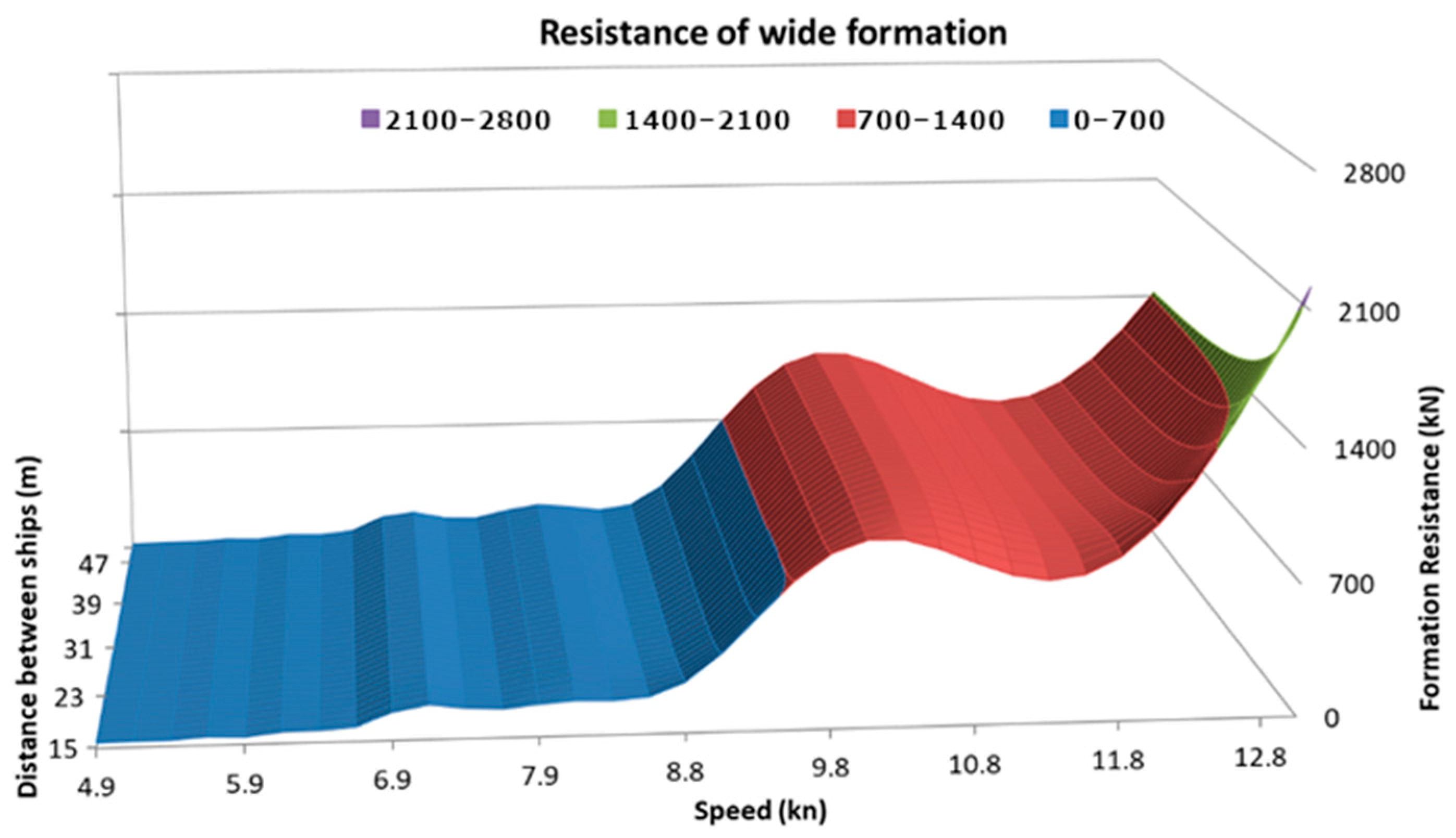
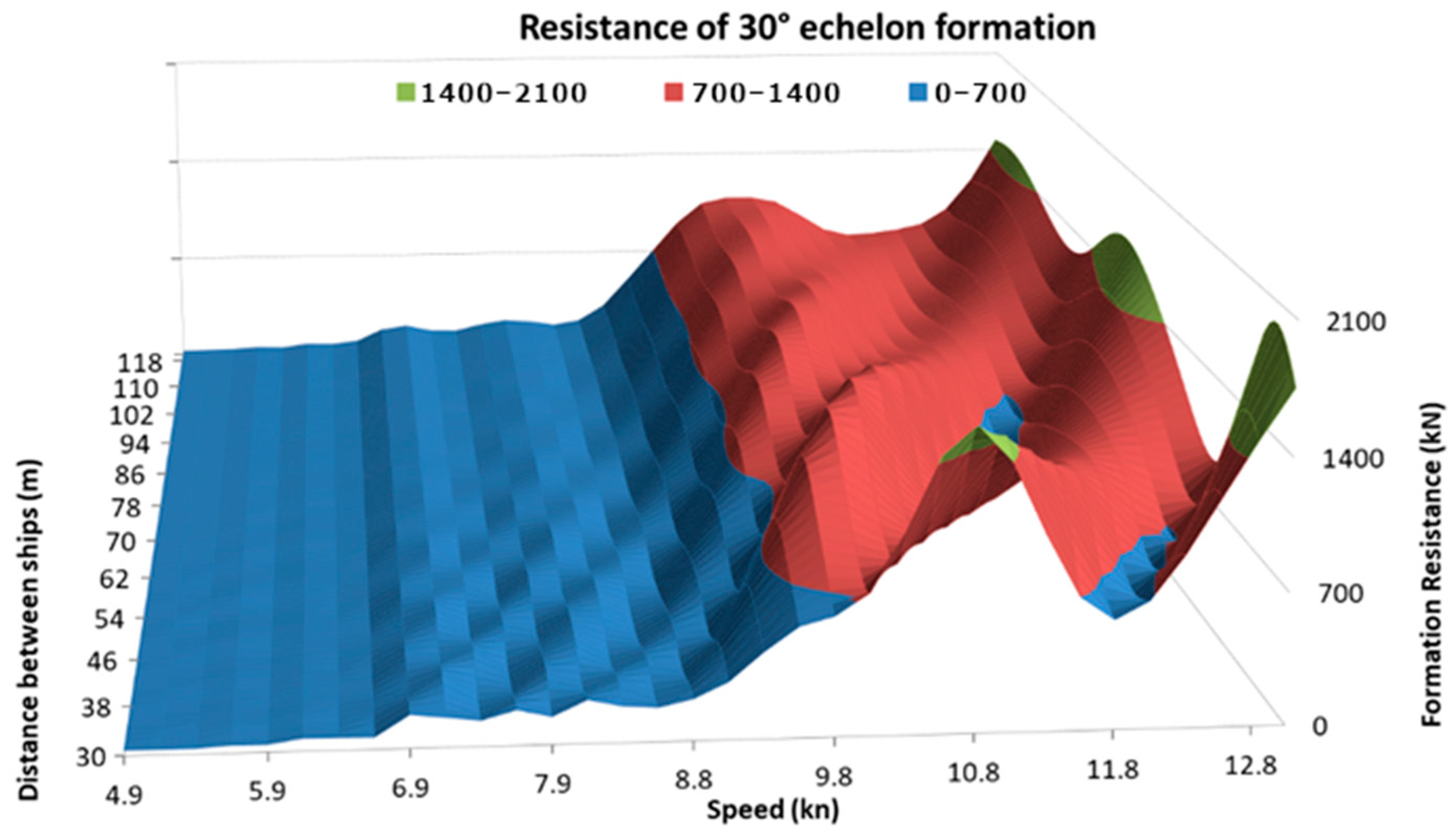
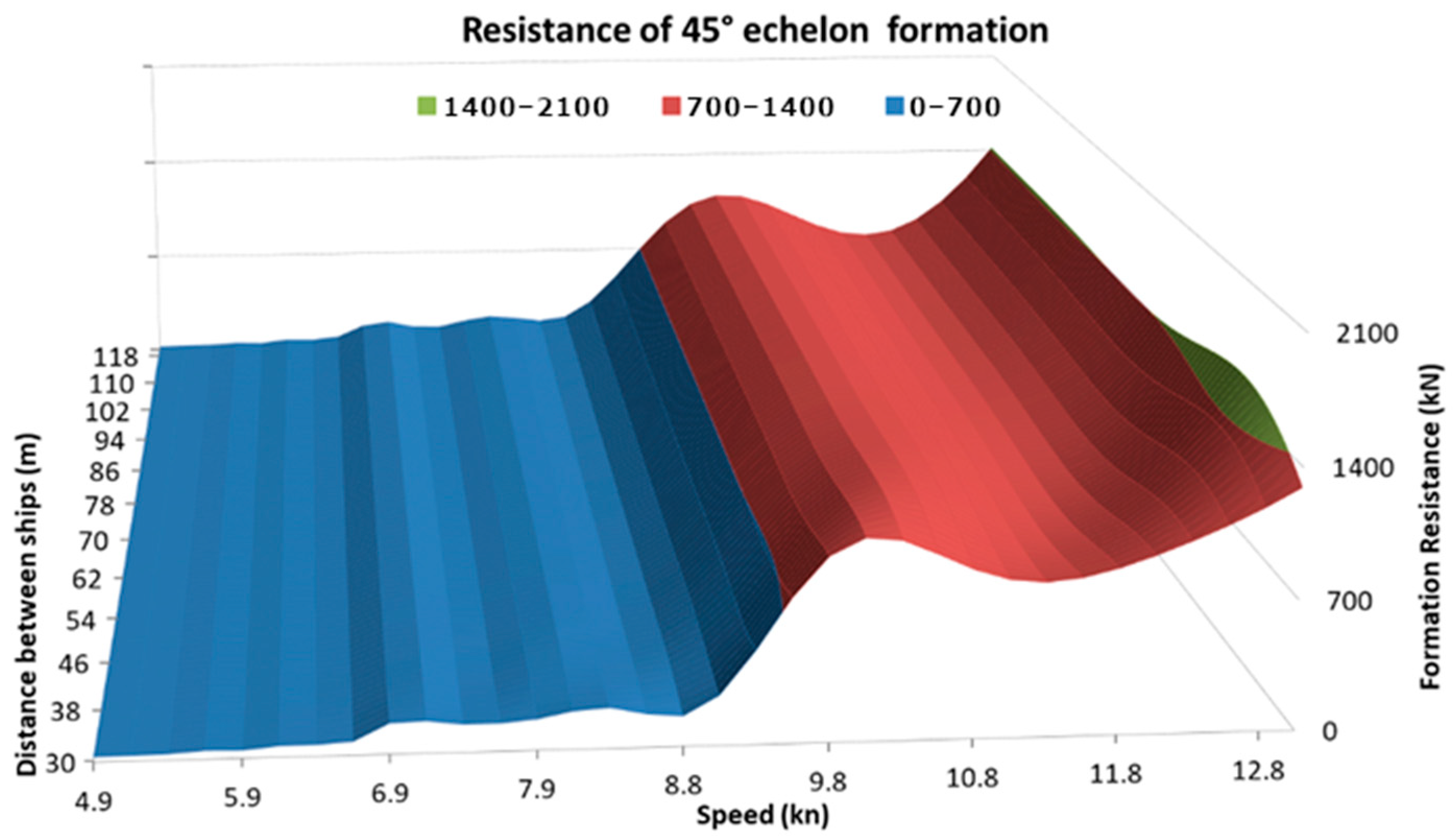



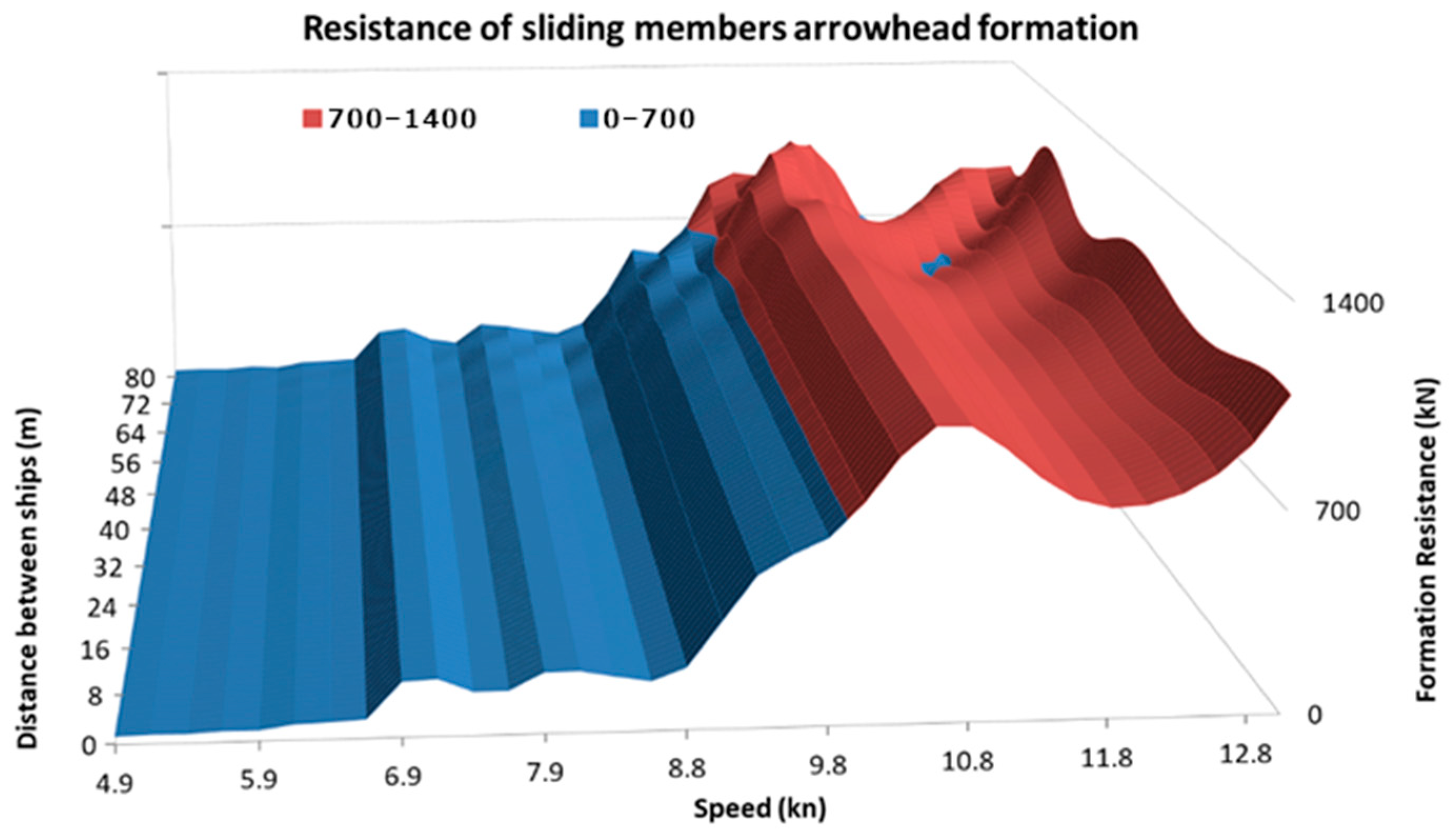
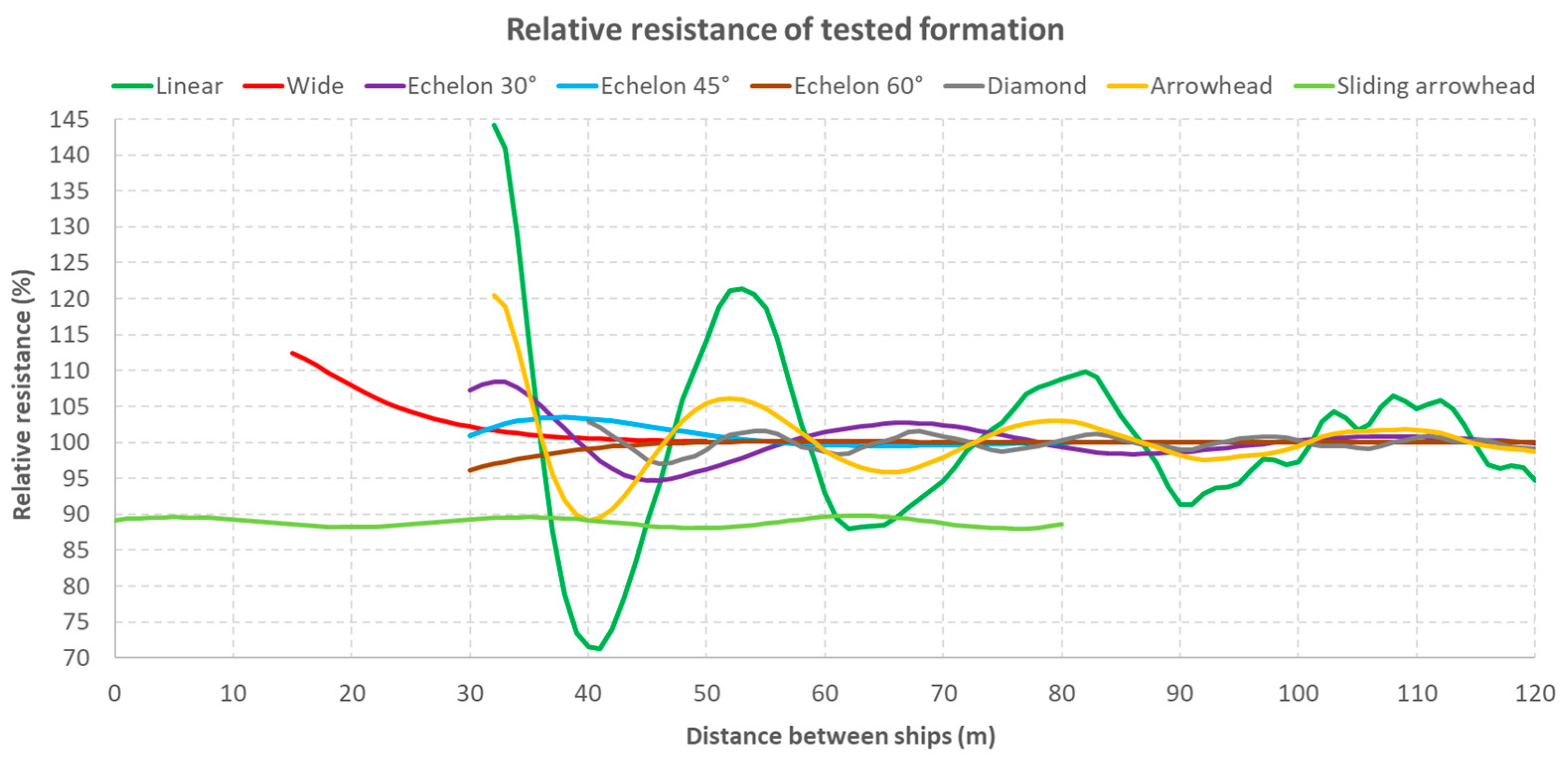



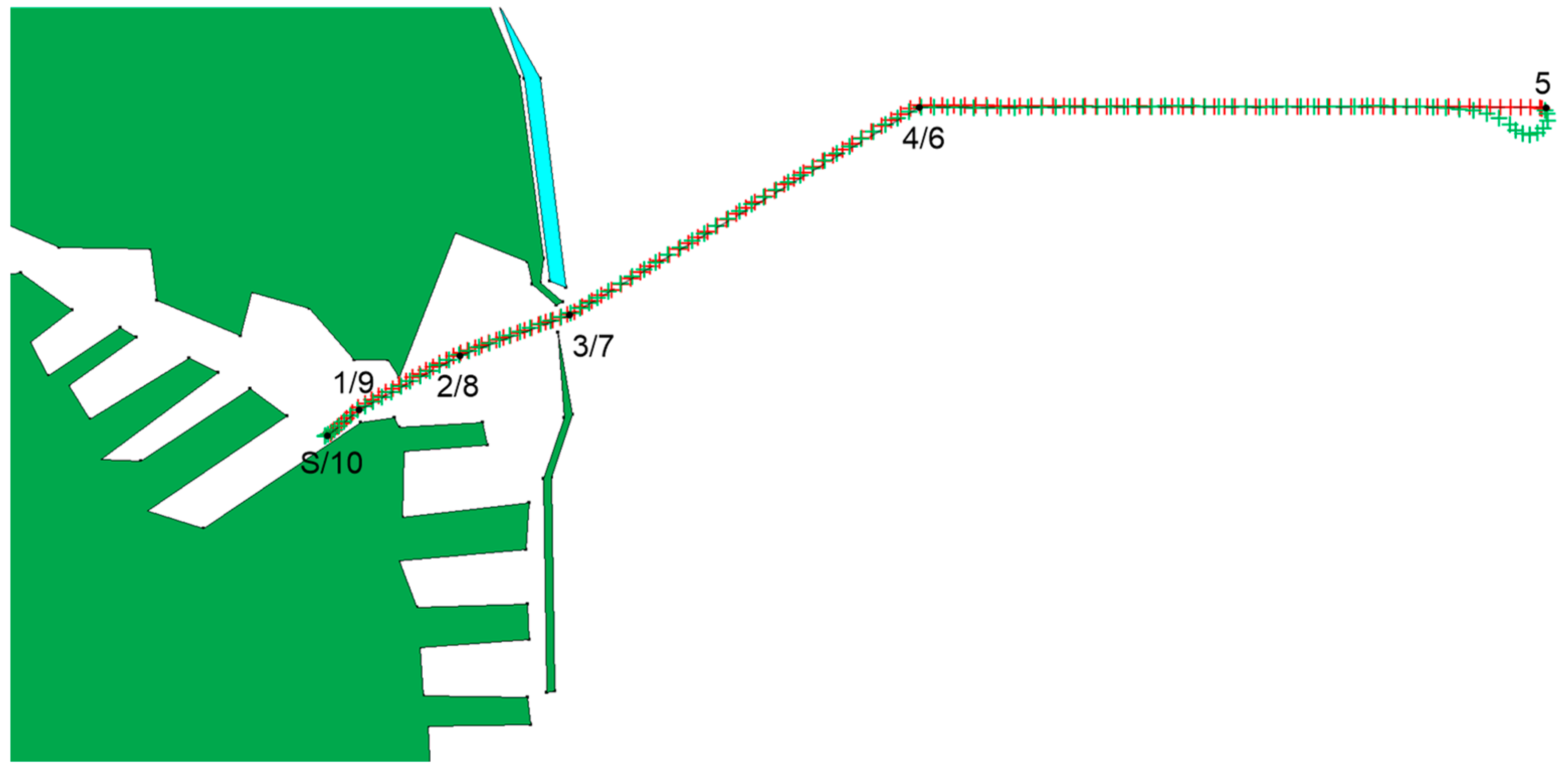

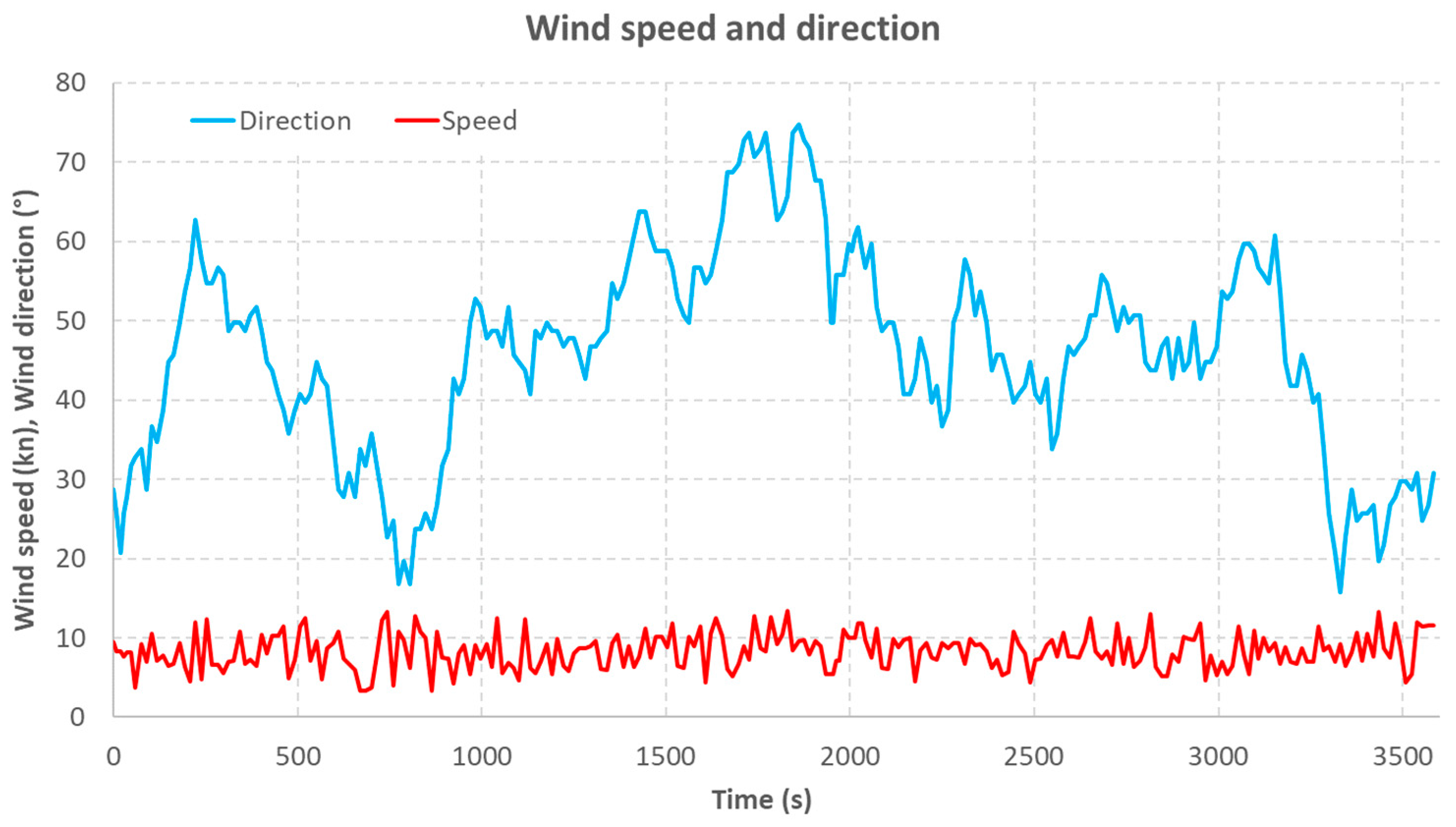
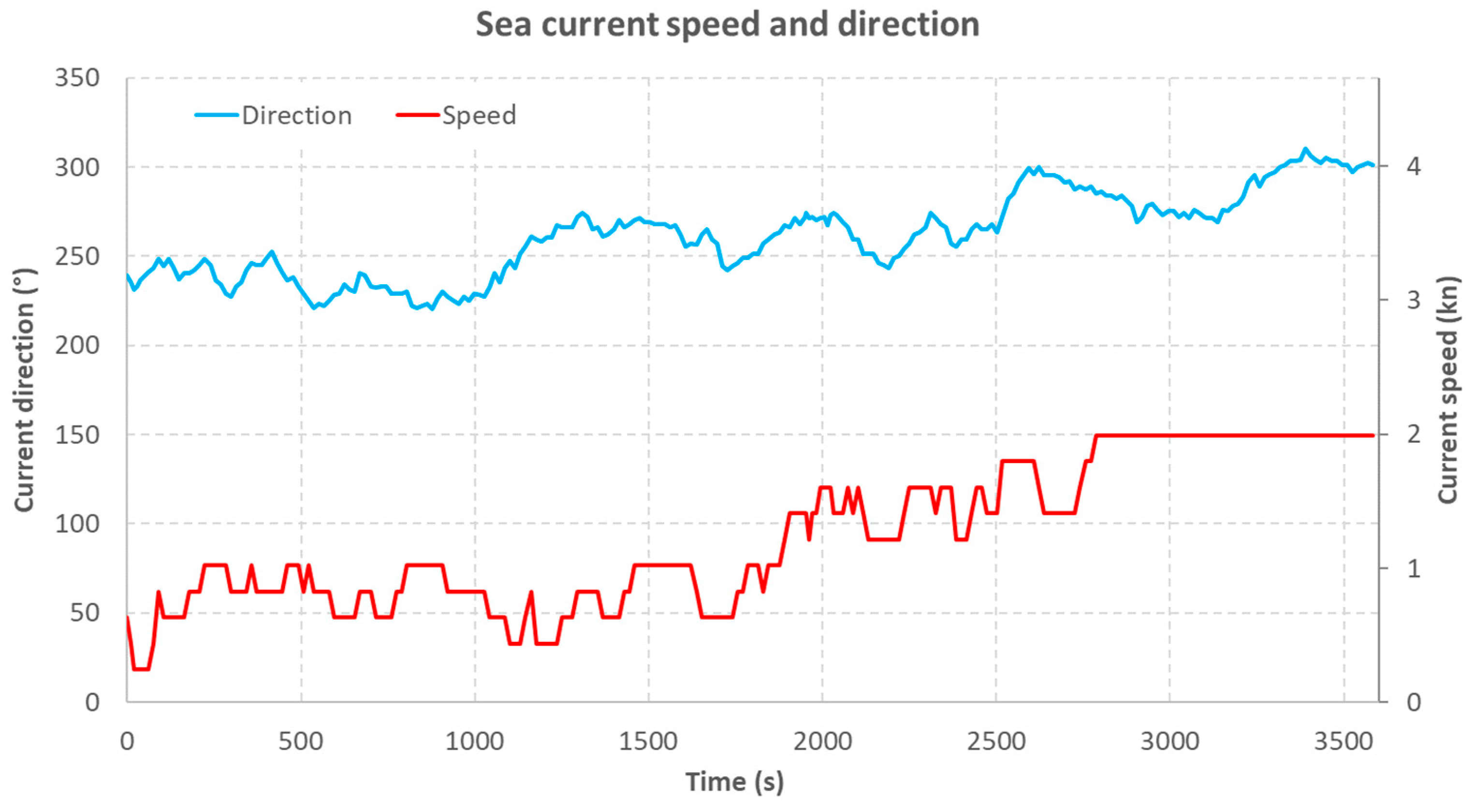

| Speed (kn) | FF (%) Friction | FEA (%) Aerodynamic | FWT (%) Wave Transverse | FWD (%) Wave Divergent | (%) Total wave resistance | FTR (kN) Total Resistance |
|---|---|---|---|---|---|---|
| 1 | 94.3 | 5.5 | 0.2 | 0.1 | 0.3 | 0.2 |
| 3 | 76.1 | 5.2 | 13.9 | 4.7 | 18.6 | 1.5 |
| 5 | 42.8 | 3.2 | 36.9 | 17.2 | 54.0 | 6.8 |
| 7 | 13.7 | 1.1 | 70.9 | 14.3 | 85.3 | 39.5 |
| 9 | 11.7 | 0.9 | 52.5 | 34.8 | 87.4 | 77.5 |
| 11 | 5.5 | 0.5 | 46.8 | 47.2 | 94.0 | 236.2 |
| 13 | 5.0 | 0.4 | 53.1 | 41.5 | 94.6 | 355.5 |
| Parameter | Designation | Value |
|---|---|---|
| Length overall | LOA | 32.387 m |
| Breadth | B | 12.512 m |
| Draft | D | 3.01 m |
| Frontal area | S | 94.9 m2 |
| Drag coefficient | cd | 0.6 |
| Top speed | vmax | 13 kn |
| Formation Shape | Speed Range | Lmin to Lmax | Kmin to Kmax |
|---|---|---|---|
| Linear | 4.9 to 13.0 kn | 32 to 120 m | n/a |
| Wide | 4.9 to 13.0 kn | 15 to 50 m | n/a |
| Echelon 30° | 4.9 to 13.0 kn | 30 to 120 m | n/a |
| Echelon 45° | 4.9 to 13.0 kn | 30 to 120 m | n/a |
| Echelon 60° | 4.9 to 13.0 kn | 30 to 120 m | n/a |
| Diamond | 4.9 to 13.0 kn | 40 to 120 m | n/a |
| Arrowhead | 4.9 to 13.0 kn | 32 to 120 m | n/a |
| Arrowhead sliding | 4.9 to 13.0 kn | fixed at 40 m | 0 to 80 m |
| Route Segment | Distance (kn) |
|---|---|
| Start—1 | 0.14 |
| 1—2 | 0.47 |
| 2—3 | 0.48 |
| 3—4 | 1.61 |
| 4—5 | 2.95 |
| 5—6 | (3.05) |
| 6—7 | 1.61 |
| 7—8 | 0.48 |
| 8—9 | 0.47 |
| 9—10 | 0.14 |
| TOTAL | 11.4 |
| Formation Shape | Energy (kWh), Electric Propulsion | CO2 Emissions (kg), Electric Propulsion | Relative Energy Consumption (%) | Energy (kWh), Diesel Propulsion | CO2 Emissions (kg), Diesel Propulsion |
|---|---|---|---|---|---|
| Independent ships | 6348.1 | 2120.3 | 100.0 | 21,160.3 | 5586.3 |
| Linear | 2688.6 | 898.0 | 42.4 | 8961.9 | 2365.9 |
| Wide | 6353.3 | 2122.0 | 100.1 | 21,177.7 | 5590.9 |
| Echelon 30° | 4256.9 | 1421.8 | 67.1 | 14,189.7 | 3746.1 |
| Echelon 45° | 5982.9 | 1998.3 | 94.2 | 19,943.0 | 5264.9 |
| Echelon 60° | 5564.8 | 1858.6 | 87.7 | 18,549.2 | 4897.0 |
| Diamond | 5169.0 | 1726.4 | 81.4 | 17,229.9 | 4548.7 |
| Arrowhead | 4789.7 | 1599.8 | 75.5 | 15,965.8 | 4215.0 |
| Arrowhead sliding | 4331.7 | 1446.8 | 68.2 | 14,438.9 | 3811.9 |
Publisher’s Note: MDPI stays neutral with regard to jurisdictional claims in published maps and institutional affiliations. |
© 2022 by the authors. Licensee MDPI, Basel, Switzerland. This article is an open access article distributed under the terms and conditions of the Creative Commons Attribution (CC BY) license (https://creativecommons.org/licenses/by/4.0/).
Share and Cite
Koznowski, W.; Łebkowski, A. Unmanned Electric Tugboat Formation Multi-Agent Energy-Aware Control System Concept. Energies 2022, 15, 9592. https://doi.org/10.3390/en15249592
Koznowski W, Łebkowski A. Unmanned Electric Tugboat Formation Multi-Agent Energy-Aware Control System Concept. Energies. 2022; 15(24):9592. https://doi.org/10.3390/en15249592
Chicago/Turabian StyleKoznowski, Wojciech, and Andrzej Łebkowski. 2022. "Unmanned Electric Tugboat Formation Multi-Agent Energy-Aware Control System Concept" Energies 15, no. 24: 9592. https://doi.org/10.3390/en15249592
APA StyleKoznowski, W., & Łebkowski, A. (2022). Unmanned Electric Tugboat Formation Multi-Agent Energy-Aware Control System Concept. Energies, 15(24), 9592. https://doi.org/10.3390/en15249592







